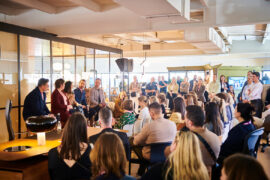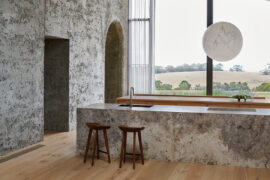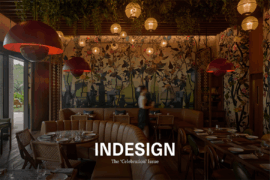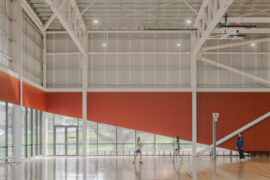The hospitality sector caters to specific needs – from eating and drinking to socialising and relaxing – so by keeping design features pared back and unobtrusive, other sensory aspects such as flavours and aromas can shine through.
The expression ‘less is more’ gets touted around a lot these days, especially since the trend towards minimalist living emerged. However, those three short words beautifully sum up the influence that minimalist design thinking can have in the hospitality sphere. For, hospitality in its various forms, provides places for people to relax, eat, socialise or work, amongst other things. And, as such, the senses ‘hearing’, ‘smell’ and ‘taste’ become particularly important in these environments, with a minimalist design approach ensuring these are not overpowered by visual elements. That’s not to say that how a hotel room or restaurant looks is not important, it’s very important, but that sometimes a more pared-back approach is better if you wish to heighten other sensory experiences within that space.
Imagine walking into a café where mouth-watering aromas of freshly brewed coffee and bread just out of the oven greets you, but the décor is all bright colours and neon lights with loud jazz music blaring over the speakers. Suddenly your other senses are assaulted and you’re less likely to notice and appreciate the delicious smells wafting from within.
A better working example is the Grande Bibliotheque de Montreal – an enormous public library in downtown Montreal. The impressive space houses some 80km of shelf space with more than four million items, two million of which are books. It also boasts a large, open café and plays host to exhibitions and tours from time to time, making it more of a cultural venue than just simply a library.
To this end, the interior design really had to cater for focus and concentration as well as socialising and retreat. Thus, natural materials such as wood and concrete have been deployed to foster a sense of calm whilst large-scale, seamless surfaces create a clean, uncluttered look that subliminally augments this tranquil vibe. Also integral to the overall design is the library’s lighting, which was supplied by Montreal design studio Lambert et Fils (available in Australia through Living Edge).
Just as the combination of raw materials, muted hues and clean lines creates a look that is both modern and luxurious yet simple and pared back, so too does the elegant lighting, which illuminates study areas, reading rooms, book shelves and the cafe. When Lambert et Fils first opened in 2010, owner Samuel Lambert began by refurbishing old lamps from his favourite eras – the 1940s, fifties and sixties. Today the brand, which has grown dramatically since then, no longer uses vintage parts but the contemporary designs still have a touch of nostalgia for mid-century modernism.




Lambert et Fils describes its product as ‘sleek yet poetic lights, in which apparent simplicity does not exclude design complexity’; the perfect choice then for a building where minimalist design encases so much information, research and creativity! Despite the lack of bright colours or superfluous embellishments, the library still feels like a warm, welcoming place to be. It’s simply that the calm décor filters into our psyches and a lack of visual distraction allows us to really concentrate on our respective activities.
INDESIGN is on instagram
Follow @indesignlive
A searchable and comprehensive guide for specifying leading products and their suppliers
Keep up to date with the latest and greatest from our industry BFF's!

London-based design duo Raw Edges have joined forces with Established & Sons and Tongue & Groove to introduce Wall to Wall – a hand-stained, “living collection” that transforms parquet flooring into a canvas of colour, pattern, and possibility.

Curated by the Indesign editorial team and hosted at leading showrooms, the Design Discussions series provided thoughtful reflection and debate on key issues shaping the industry.

The INDE.Awards 2025 has named House on a Hill by Leeton Pointon Architects and Allison Pye Interiors as the winner of The Interior Space category, presented by Tongue & Groove. This multigenerational country home on Bunurong Country redefines residential architecture and design with its poetic balance of form, function, and sanctuary.
The internet never sleeps! Here's the stuff you might have missed

The latest print magazine is about to arrive! With Guest Editor Colin Seah of Ministry of Design (MOD), Singapore flooding our world with love, we are ready to party in style!

Joan Montgomery Centre PLC by Warren and Mahoney is a tour de force of education design, with high-end facilities including a swimming pool and general athletic amenities.

With the Evershield® Anodising 50-Year Warranty, AAF offers peace of mind that architectural aluminium will remain vibrant, resilient, and beautiful for generations.

Pedrali’s Nemea collection, designed by Cazzaniga Mandelli Pagliarulo, marks 10 years of refined presence in hospitality and commercial spaces around the world. With its sculptural timber form and enduring versatility, Nemea proves that timeless design is never out of place.